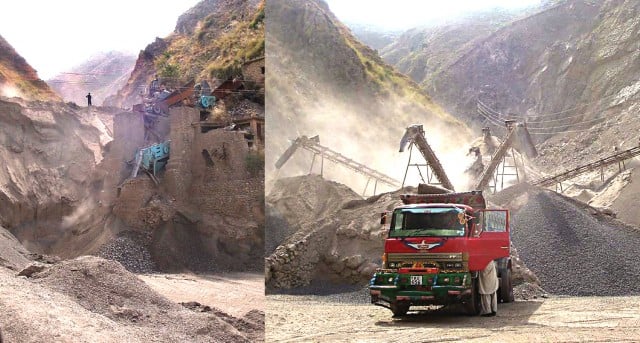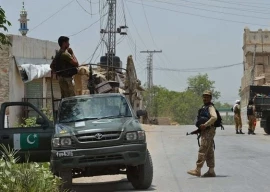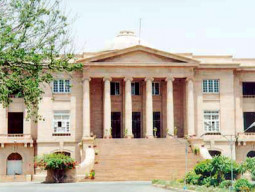
Despite many attempts by the government to halt the practice, the four-decade-old legacy of stone crushing continues as hills disappear. The numerous directions, notices and orders issued by the government have failed to curb the profitable business which employs approximately 150,000 people.
On way to Abbottabad, about an hour and a half from Islamabad, on the right are the lush-green Murree Hills, Nathiagali and Baarian, while on the left are horrific sites of ‘scooped’ mountains, some peaks almost invisible and stone crushers operating in full swing. About 18 crushers are working there.
Environmental disaster
According to a social worker from the area, Jawadullaha Khan Abbasi, the destruction of the hills has caused severe health problems in the area, such as hepatitis, TB and skin infections. The residents of the area also face other issues such as noise pollution caused by dynamite explosions, heavy machinery and about 80 trucks crossing Ghora Gali Lora Road in district Abbottabad daily.
Moreover, stone crushing has led to the drying up and contamination of natural streams, the destruction of natural geographical formations, archaeological features and native plant communities. It has also forced native birds to migrate from the area, says Abid Swati, an environment expert in Khyber-Pakhtunkhwa.
“A team from the Enviro-nment Protection Agency (EPA) visited the site about five months ago and the federal government directed the Khyber-Pakhtunkhwa government to stop stone crushing in Abbottabad Hills immediately. However, the practice needs to be checked again,” says director-general EPA Asif Shuja.
“Stone crushing is a never ending story,” says Shuja. “Stone crushers continue to work despite the fact that their licences have expired.” There are about 213 stone crushers working close to the ruins of Taxila who were given leases in the 1980s. The EPA has asked the provincial government not to issue new licences or give out new leases. The case of stone crushing in Taxila has been moved to the Punjab Tribunal of the EPA and is still pending.
Official failure
In 1995-1996, crushers were stopped from operating in the national park area which comprises Pirsohawa, Daman-e-Koh and Shakarpariyan. Thirty crushers operating in Taxila were also shut down. However, two illegal crushers are still operating there.
And in 2006, the EPA declared 1000 yards from Margalla Hills a no-crushing zone. In 2006-2007, the Punjab government gave a three-year lease to the Margalla Hills Association for the rehabilitation of the area, but crushing continued. Many of the crushers are working despite the expiration of their leases.
Meanwhile, the Punjab’s Mines and Minerals Depart-ment sent a summary to the chief minister to carry out crushing the no-crushing zone, but the proposal was refused.
“It is commonly said that Islamabad has been constructed with the stones of Margalla Hills,” says Shuja. “Approximately 40,000 tons of stone per day is taken from Margalla and is moved all the way to Sindh. If the trend continues, soon we will not see any more hills but only concrete blocks in the capital.”
Published in The Express Tribune, July 3rd, 2010.

1731329418-0/BeFunky-collage-(39)1731329418-0-165x106.webp)















COMMENTS (2)
Comments are moderated and generally will be posted if they are on-topic and not abusive.
For more information, please see our Comments FAQ